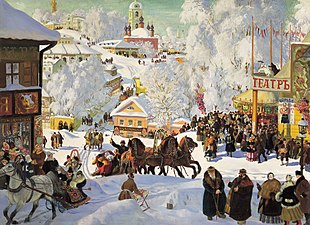Maslenitsa



The Maslenitsa (stress on the first syllable; Russian Масленица , Butter Week ' ) is a traditional East Slavonic feast at the end of winter, which lasts a week. It is originally a pagan and not a Christian Orthodox celebration, but since the Christianization of the Rus it has corresponded with the Christian festival cycle . While related customs exist in all Orthodox cultures, this article deals specifically with the Russian form of these customs.
Origin of name
Maslenitsa refers to the week before the start of Orthodox Lent . The name - Maslo means 'butter' in Russian - comes from the fact that this week Orthodox believers are already forbidden from consuming meat, but milk, dairy products, eggs and fish are still allowed.
Temporal course
Maslenitsa is a very exuberant festival, where people indulge in gluttony before fasting. In its traditional form, it is associated with various customs, some of which were linked to fixed days in the course of a week. Central and most widespread among the people are the burning of the Maslenitsa doll and blini (pancakes) as food at this time. These are eaten pure as well as with various fillings at the festival. The traditional, full course of Maslenitsa in Russia is as follows:
- Monday was the day when Maslenitsa was welcomed , especially by the children, and a large doll, the Maslenitsa doll, was made out of straw.
- Tuesday was the day of the games , on which there were all kinds of street performances, plays and balls and the young people went looking for a bride.
- On Wednesday, the day of the sweet tooth , the sons-in-law met their mothers-in -law for a festive blini meal, for which the sons -in-law also had to reciprocate with a bliny meal on Friday, the mother-in-law's evening.
- Thursday was mainly for the young married couples. The newly weds last year gathered in public and stood in pairs to express their love for one another while the audience cheered.
- Saturday, the day of farewell , was celebrated with visits to relatives.
- The festival ended on Sunday, Forgiveness Day , with the solemn burning of the Maslenitsa doll. While hugging each other, they asked each other for forgiveness for past misconduct in order to be able to start the Lent free from contaminated sites.
The doll that is burned at the end traditionally has different shapes. In the new Russia, a figure in the form of a woman has prevailed, in older times animal or fur-coat dolls were also common in the region. They are mostly made of straw.
history
The festival goes back to pre-Christian Slavic traditions . It was celebrated from the beginning on the farewell of winter and before the Christianization of the Eastern Slavs in honor of the Slavic fertility god Veles . It got its current name in the 16th century, up to which it represented a kind of extended New Year's festival at the same time and was comparable to the German New Year's Eve . According to the tradition of the Russian people at the time, the year began with the beginning of spring. From this, after the implementation of the western calendar, the Maslenitsa developed into a pure festival to say goodbye to winter, similar to other spring festivals around the world. Among other things, there have been attempts not to sell alcohol at street festivals in the big cities. The high point of the Maslenitsa tradition was the 17th to 19th centuries.
After the October Revolution of 1917, the practice of the custom declined sharply. It was kept on a smaller scale, especially in rural areas. However, the Maslenitsa tradition revived shortly after the end of the USSR and after the millennium developed into a folk festival with fairs and parades, which were integrated into the traditional elements of the celebration from the Tsarist era . There are very large Maslenitsa celebrations in and near Moscow , where the festival is promoted as a tourist attraction by the city authorities. One location for the celebrations is a central stage on Red Square .
Web links
- Article about the butter week in online journal
- Film about a Maslenitsa celebration not far from Moscow at russland.RU
- Photo series about the Maslenitsa in Moscow by Die Presse
Individual evidence
- ↑ a b Oksana Fedotowa: Maslenitsa (Pancake Week). In: SAGEN.at. Wolfgang Morscher, 2006, accessed March 1, 2012 .
- ↑ Maslenitsa - Carnival the Russian way. In: RusslandJournal.de. URRA Interactive, accessed March 1, 2012 .
- ↑ a b Polina Sorel: Maslenitsa - Butter Week - Russian Carnival. In: www.russian-online.de. Retrieved March 1, 2012 .
- ↑ a b c Yevgeny Hapersky: Maslenitsa in Moscow - being funny even without alcohol. In: DW. Deutsche Welle, February 24, 2009, accessed February 7, 2015 .
- ↑ Maslenitsa. (No longer available online.) In: russland.RU. March 21, 2009, archived from the original on November 3, 2013 ; Retrieved March 1, 2012 . Info: The archive link was inserted automatically and has not yet been checked. Please check the original and archive link according to the instructions and then remove this notice.
- ^ André Ballin: Maslenitsa in Moscow is supposed to replace the carnival in Rio. In: moscow.RU. RUFO, February 27, 2008, accessed March 1, 2012 .